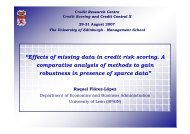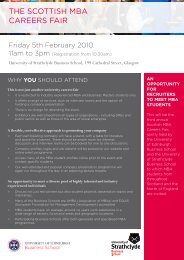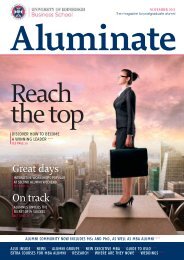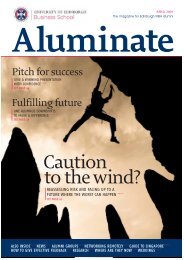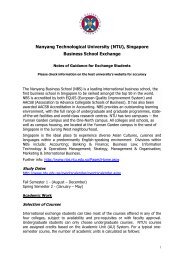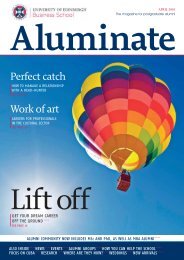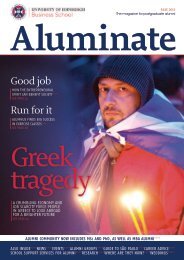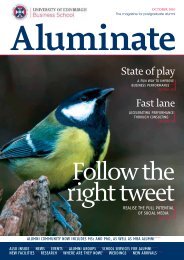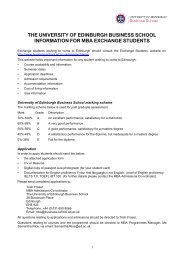killed Saab Automobile? - Business School - University of Edinburgh
killed Saab Automobile? - Business School - University of Edinburgh
killed Saab Automobile? - Business School - University of Edinburgh
You also want an ePaper? Increase the reach of your titles
YUMPU automatically turns print PDFs into web optimized ePapers that Google loves.
to be too much, and the company was taken into public ownership in the mid 1970s. Volumes fell from<br />
a peak <strong>of</strong> over a million units a year to around 400,000 units, where they stabilized for a number <strong>of</strong><br />
years. Even this reduced figure was about triple what <strong>Saab</strong> ever achieved, albeit spread across many<br />
more models.<br />
Rover enjoyed a successful collaboration with Honda from the late 1970s to the mid 1990s in which<br />
Honda provided designs and production know-how. This revived the company’s fortunes and it was<br />
privatized through its sale to British Aerospace in 1987. Ironically, at the time <strong>of</strong> the sale there many<br />
commentators drew parallels with <strong>Saab</strong> Cars, then still part <strong>of</strong> an aerospace and defence conglomerate<br />
itself, and spoke <strong>of</strong> the synergies between the aerospace and automotive operations. By the late 1980s<br />
BLMC had been through several name changes and was using the Rover brand on its cars, part <strong>of</strong> an<br />
attempt to position itself as a moderate volume, semi-premium producer.<br />
In 1994, Rover was bought by BMW. Honda ended collaboration at that point, which in due course<br />
revealed the true extent <strong>of</strong> Rover’s dependency on Honda’s know-how. BMW initially adopted a hands<strong>of</strong>f<br />
management approach to Rover, but as things started to go downhill became more interventionist.<br />
An executive model, the Rover 75, was launched in 1998 but despite being reasonably well received by<br />
the motoring press failed to sell as expected. In 2000, BMW sold Land Rover to Ford, the Rover-braned<br />
volume cars business to a consortium <strong>of</strong> business man (the Phoenix Consortium) for £10, but retained<br />
the new Mini, which was just about to launch. The Mini has subsequently been a great sales success<br />
for BMW.<br />
In 2000, Rover Cars thus found itself with a partial and aging model line up, apart from the quite new,<br />
but poorly-selling 75, no product development capability and precious little capital, in an industry beset<br />
by over-capacity. This was not unlike the situation faced by <strong>Saab</strong> in 2010. Like Muller with <strong>Saab</strong>, from<br />
the outset, Phoenix attempted to find a partner for Rover, but were unsuccessful in doing so. As<br />
matters became more and more desperate, Rover bought in a cheap economy model from Tata <strong>of</strong><br />
India, which it rebadged as ‘City Rover’, sold much <strong>of</strong> its remaining intellectual property to the Chinese<br />
auto company SAIC and even sold its own site to a property company and leased it back. When the<br />
end finally came, Rover’s remaining assets were sold to another Chinese company, Nanjing<br />
<strong>Automobile</strong>. This did not include the Rover name itself, which had been sold to Ford along with Land<br />
Rover in 2000. Consequently Nanjing, who later merged with SAIC, was forced to create a Roversounding<br />
name for its vehicles - Roewe.<br />
Production <strong>of</strong> MG vehicles restarted in the UK in 2008 with very small volumes <strong>of</strong> the MG TF LE500<br />
sports car. lxxxiii<br />
SAAB AND ROVER COMPARED<br />
How do the stories <strong>of</strong> <strong>Saab</strong> and Rover compare?<br />
First, <strong>Saab</strong> and some elements <strong>of</strong> what became Rover, via BLMC, both had strong, niche brands that<br />
struggled with issues <strong>of</strong> scale. For example Jaguar and the original Rover car company itself both<br />
occupied the premium end <strong>of</strong> the market, had distinct identities and modest volumes before their<br />
eventual assimilation into BLMC. True, their identities were not the same as that <strong>of</strong> <strong>Saab</strong>, but some <strong>of</strong><br />
the issues they faced were similar. However, <strong>Saab</strong> was spared the ordeal <strong>of</strong> amalgamation with a<br />
multitude <strong>of</strong> other equally weak car companies, with very different brands and positions in the market,<br />
something which did lasting, and in our view fatal, damage to the stronger parts <strong>of</strong> the BLMC/ Rover<br />
Group.<br />
32




